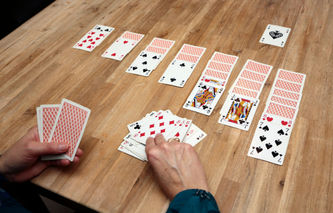Let's face it; earning enough money to pay your monthly bills and fund a retirement account is the start of the financial planning process. We've recognized the importance of developing a career to maximize you earning potential. Our career development section contains information that should help you find a good job and be successful.
Our formula to career development is a three pronged approach
Resume Writing
The first step in resume writing is to get down what you know and learned into a resume that going to advertise your services in a way that will get you noticed. This process starts with a resume that highlights your achievements and downplays your shortcomings. Our resume writing guide can help you choose between the three most common resume types - combination resumes, functional resumes and chronological resumes.
Once you've figured out the best resume style, we're going to help you get started writing your resume with our resume wizard and free resume samples. We've even got targeted resumes for accountants, nurses and police officers. We're just starting to include some information on cover letters too.
Finding a Job
While you're working on your resume, we've also got some tips that can help you find a job. Here we've covered a great deal of options that you have ranging from working abroad to part time jobs.
We've also got quite a bit of information targeted to college students, and teens looking for a job. At the other end of the spectrum, we can help professional working on their networking skills or with some advice on dressing for an interview.
If you've been thinking about working from home or you've heard about internet jobs that allow you to work from home, we've got that area covered too.
Find Jobs by Industry
Before you can find the right job, it helps to consider what kind of industry you'd like to work in. If you already have some idea of the kind of work you'd like to do, learn about some of the best options here.
Find Jobs by Salary
Even if you don't have a college degree and aren't sure which industry you'd like to work in, you still have plenty of options. Discover some of the best-paying jobs here.
Find Side Hustles
What if you'd like to earn some extra cash on top of your regular 9-5? More and more people are pursuing side hustles, with a portion of them flourishing into full-blown businesses. Here, we list your best options and provide guidance on how to get them.
Leadership Skills
Once you've found the right job, it's time to prove that you can be a trusted leader in that organization. Here we think we've got some of the most comprehensive information you'll find on any website when it comes to understanding leadership styles and theories.
If you don't think leadership theory is important, then take a look at our article onsituational leadership. Whether you're an autocratic leader or charismatic one, it's important to know how to apply your leadership skills to different situations you'll encounter at work.
Career Dictionary
Finally, if all the career jargon has got your head spinning, take a look at our career dictionary. We've got a glossary of 100 career-related terms that can help you come up to speed on the latest words you'll encounter while looking for a job or on an interview.
There are no articles in this category. If subcategories display on this page, they may have articles.
Subcategories
Finding a job is not always easy in today's economy. Sometimes all it takes is a bit of advice to help get your job search started. Whether it's searching for a job, or improving your interview skills, we can help you get on the right track.
Many experienced job hunters have a very good idea of how to go about finding a job; we recognize that fact. That's why we've focused on individuals that are new to the workforce, teenagers and college students, because finding that first job is sometimes difficult.
We also recognized the Internet plays an increasingly important role in stay at home / work from home jobs. Finally, if you're already working, but are questioning whether or not you're in the right job, our articles dedicated to evaluating your career can help there too.
Conducting a Job Search
Finding a new job is not always easy. You may have been working for one company your entire career, or you might be thinking about re-entering the workforce after taking several years off. Below are links to information that can help you to start your job search:
Job Applications
Oftentimes, your first introduction to a potential employer is through a job application. This next series of articles tells you all you need to know about filling out job applications, and how to go about applying for a new job.
College Students Looking for Jobs
Whether you're still in college, or looking for your first job after graduating, we have some good information for college students looking for jobs. The challenge for college students is to be recognized for what you know and have learned, as well as leveraging the resources you have at your disposal at school.
Teenagers Looking for Jobs
We all remember how awkward it can be when trying to find your first job as a teenager. If you're a teen that wants some spare pocket change this summer, we've tried to take a lot of the mystery out of the process by putting this series of articles together just for you:
Job Interviews
Making a good first impression is important. When you're on a job interview, you'll want to make sure the hiring manager really understands the potential value you bring to their organization. We have many tips on the topic of job interviews; what to say and what topics to avoid:
Working from Home
Technology has really changed the way we gather information and interact with each other. The Internet in particular has opened up a whole new way of conducting business from home.
If this sounds appealing to your lifestyle, here are some resources you might want to explore. These articles cover the pros and cons of working from home:
Also, there is another practice coupled with working from home which is called BYOD (Bring Your Own Device).
Specialty Jobs
One function that is often overlooked by job seekers is the role that specialty jobs can play in laying down a good foundation for your career. Whether it's part time work or volunteering, all of these jobs add to the marketability of your resume, and can make you feel good at the same time:
Evaluating Your Career
If you've reached that point in your career where you're in need of change, then it's probably time to step back and evaluate your career. You're going to spend a good deal of time at work, so it's important to figure out that balance of what's important to you at home and what's important at work:
If you've been working for a while, you've probably come to realize that there are a lot of smart people in the workforce. This age of information has turned many workers into technical experts, nearly overnight. But for those of you that want to be recognized as future leaders of their organizations, you need to start to separate yourself from the rest of the pack.
If you want to distance yourself from the technical experts, or just make yourself stand out, you'll need to prove that you can be trusted to lead others. To do that you'll need to improve your leadership skills.
Studies in Leadership Theory
To really understand what leadership is all about, you need to build your knowledge base from a good foundation of theory. It's not enough to simply pick a leadership style, or be told that you're using a specific leadership technique. Effective leaders are just that, they are effective in nearly all situations, and this consistency of success comes from understanding theory like conditional leadership and the pros and cons of each style:
Leadership Characteristics and Skills
We've all heard about natural born leaders. While it's debatable whether or not leaders are born, we think they are shaped by their environment and by their observation of others. If you've been wondering what makes a good leader tick, here's some information on the qualities and skills you might or might not readily recognize in a leader:
Leadership Development and Training
The world is moving faster than ever, and if you want to move up in an organization, then you might need a jump start when it comes to leadership development and training. If you're not sure if a leadership course is going to be worth your time, just take a look at some of our advice:
Women Leaders
Don't tell any of these women that there's a glass ceiling when it comes to leadership positions. In these articles, we've highlighted some of the outstanding women in the workplace, and the political leaders of today and yesterday:
Social Aspects of Leadership
If you don't think there are social aspects of leadership, then you must have missed some of the news articles highlighting the lack of true leaders in the aftermath of Hurricane Katrina. It's not just enough to be a leader; it's the consistency of its application that's so important too:
Specific Leadership Styles
If you're already familiar with some of the leadership theories, and you're looking for more specific information on a leadership style, we can help there too. If you don't see what you're looking for today, come back soon; we'll continue to add to this area over the next several years:
Foreign Leaders
Finally, there is no doubt that the United States is a world leader in many different ways. But as Americans, many of us don't completely understand the other world superpower: Russia. If you're looking for some information on the politics and dynamics between the U.S. and Russia, we have this specialty section just for you:
Our approach to resume writing is quite simple: a resume is a personal advertisement for your services and it has to be a good one. It's your resume that gets you noticed by a recruiter or hiring manager. That means the upfront work involved with putting together a resume that will highlight your achievements and downplay your shortcomings is well worth the effort.
Resume Types
The first step in putting together a resume that gets results is to pick a resume format that matches up well with your career. There are basically three types of resume formats that you can choose from: combination, chronological and functional. The articles below explain the pros and cons of each resume type, and should be your first stop before you start writing:
Building Resumes
Once you've decided on a resume format, the next step is to start building your resume. The last thing you want is a disorganized resume, or one that uses too many fonts or colors. You want one that looks professional, and allows the reader to quickly find the information they are looking for. This is where resume wizards and templates can help:
Resume Samples and Examples
While we always emphasize the fact that your unique and individual career information on a resume is the most powerful information you can share with a hiring company, we do realize that samples and examples help.
This is an area we will continue to build over time, but a list of the examples we've already put together includes:
Resume Writing Tips and Guides
Once you've put together your resume, it helps to continually get new ideas and refine the document over time. We're not talking about redoing the document from scratch; we're talking about polishing a resume to make it shine.
This is an area where guides on resume writing tips and help can lend a hand:
Getting Your Resume Noticed
Now that you have your resume together, it's time to get it out there and get it noticed. Our final bit of advice on resume writing has to do with the different types of resume writing and distribution services that you might want to consider:
Cover Letters
Many times when you're writing to a company you'll need to include a cover letter. This is a completely different topic from resume writing, and it really deserves its own section. The approach you take in putting together a cover letter is sometimes more important than a resume; after all, it might be the first piece of paper they see.
Here is some information to help you get started on your cover letter:
Electronic Resumes and Cover Letters
Many companies now require job applicants to submit electronic resumes and cover letters. If you want to be asked on a job interview, then you need to be able to separate yourself from the rest of the competition. This series of articles provides you with the information to be successful in this electronic age.














.jpg)





